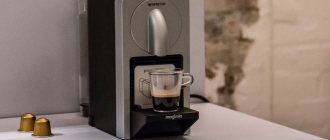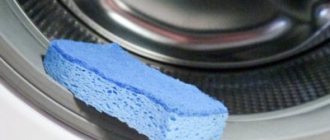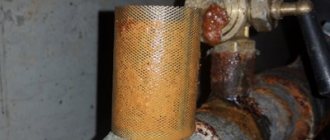All owners of washing machines know that equipment from time to time needs to clean the internal parts from dirt and deposits. Even with careful use of the machine, it is impossible to prevent the appearance of scale that occurs due to exposure to untreated tap water and chemical compounds in washing powder.
You can effectively clean your washing machine using regular table vinegar.
Many users wonder whether it is possible to remove scale, dirt and get rid of unpleasant odors using acetic acid. Let's talk about this further.
Causes of plaque and dirt
The most common cause of plaque is hard water.
It contains a large amount of magnesium and calcium salts, which during the washing process settle on all internal surfaces of the washing machine in the form of limescale.
It does not dissolve in water, turning into a thick layer of scale on the heating element, drum, filter, powder receptacle.
The appearance of an unpleasant odor is caused by fungal mold and entire colonies of microorganisms, for which the most favorable environment is formed in the washing machine:
- high humidity;
- comfortable temperature;
- small particles of dirt and crumbs (serve as food for microbes).
Don't forget about the garbage that ends up in the drum along with dirty clothes and linen. Even intensive rinsing is not able to remove absolutely all particles - active care is required.
Did your washing machine break down due to scale?
Not really
Why do you need to clean your washing machine?
A household appliance should output clean things, but the working surfaces of this device are not always sterile. As a result of prolonged use, dirt accumulates on the drum and side walls of the device, which has separated from the clothes during washing. If you look closely, you can see black spots on the joints of the drum, as well as on the rubber seal. Dark spots are not dirt, but developing colonies of fungus.
Attention!
A kitchen designer
has started working on our website . You can get acquainted with it and design the kitchen of your dreams completely free of charge! A wardrobe designer can also be useful.
In addition to the drum, deposits also appear on the heating elements, which are literally overgrown with salt deposits. If you do not take any action, then soon an unpleasant odor will emanate from the washing machine; later it will penetrate into clean clothes left in the machine overnight. Failure to take the necessary preventive actions can lead to damage to the device, so it is better to clean the washing machine with citric acid and soda in a timely manner than to buy heating elements or call a technician to repair expensive equipment.
Dirt, plaque and other accumulations appear on the surface of the washer for the following reasons:
- excessive saturation of tap water with minerals;
- use of low-quality powders or other types of detergents;
- violation of the washing machine operating rules.
If an unpleasant odor appears or traces of fungus are found on the drum, immediate action should be taken. To clean the internal surfaces from dirt, use a kitchen sponge and warm water with chemical detergents.
Can I use vinegar?
Vinegar, which is familiar to us, has proven itself to be a good remedy for regular care of household appliances. The following properties of the solution are of particular value:
- disinfectants – fights pathogenic microorganisms and fungi;
- dissolving – allows you to soften scale and effectively remove it from contaminated surfaces;
- deodorizing - perfectly eliminates unpleasant odors, and the characteristic sour aroma quickly disappears;
- whitening - copes well with dark spots and coloring components.
Such results can be obtained after using white table vinegar with a concentration of 9% - it is absolutely transparent and leaves no traces behind.
You cannot use apple cider vinegar or wine vinegar for cleaning - they contain natural dyes and can leave streaks.
But concentrated vinegar essence is suitable - just dilute it with clean water in a ratio of 1 to 7 to get regular vinegar for cleaning.
You can clean your refrigerator with vinegar, described in detail here.
Advantages and disadvantages of the method
Cleaning the washing machine with a bite gives the housewife at least 6 advantages:
- savings - low price makes the product accessible to everyone, even families with low income;
- crystal clear - vinegar not only removes dirt, but also effectively dissolves scale along with limescale;
- antibacterial effect - acid is destructive to mold and pathogenic microorganisms;
- safety for equipment - if the proportions of the cleaning components are observed, the working elements of the washing machine will not be damaged in any way;
- safety for humans - vinegar does not emit dangerous vapors and does not require the use of protective devices;
- pleasant aroma - unwanted odors and signs of mustiness will go away along with germs and dirt.
This method also has several disadvantages:
- Failure to comply with the proportions of components and the cleaning algorithm can lead to damage to parts of the unit, especially rubber seals;
- the pungent smell irritates some housewives who prefer to abandon vinegar in favor of other means.
The problem of a strong odor is easily solved - just add a few drops of any essential oil with a pleasant aroma to the cleaning water. Don’t forget to open the windows after completing hygiene work - the smell will quickly disappear.
Using soda solution
An equally effective and efficient prevention method is to clean the washing machine with vinegar and soda. This method requires less time than the previous one. It will require:
- Dilute a quarter glass of baking soda in the same amount of water.
- Pour the resulting solution into the tray of the machine.
- Pour two cups of 9% table vinegar or essence brought to the same concentration into the drum.
- The longest boiling program is set.
At the end of the cycle, you can simply open the door to remove the unpleasant smell, or run the car idle. In this way, you can effectively descale not only the heating element, but also other parts of the washing machine.
Detailed step-by-step instructions
For cleaning to be 100 percent effective, you will have to pay attention to every detail of the washing machine - from the body to the filter and powder receptacle.
External surfaces
Simply wiping with a damp cloth will not be enough to fully clean your assistant’s body. Especially if the washing machine is installed in the kitchen, ordinary water cannot cope with a layer of grease and soot.
You will need a special solution prepared from 1 liter of water and 50 ml of table white vinegar.
For effectiveness, you can add a little dishwashing detergent to the preparation.
Soak a cloth in the resulting solution, wring it well and wipe all outer surfaces of the case. Handle the digital panel carefully - the rag should just be damp, not wet, so as not to harm the electronics. For very dirty areas, use baking soda. Finish the work by wiping the surfaces with clean water.
Drum
Clean the drum using the following algorithm:
- Check that the washer is free of things.
- Pour 250 ml of vinegar with a concentration of 9% into the powder receptacle.
- On the display, set the longest mode at the maximum temperature (the exact indicators will depend on the model of the unit).
- Press start, and after 20-25 minutes, when the water in the drum heats up, pause the selected mode and leave for 1-1.5 hours. This time is necessary for the liquid to dissolve the layer of limescale and dirt.
- After an hour and a half, start the wash again - let the cycle complete.
- Prepare a cleaning solution according to the recipe from the previous section - water + vinegar + dish soap. Treat the inner surface of the drum, the sealing ring and the door with the resulting mixture.
- Turn on the washing machine again - this time select the shortest cycle with double rinse. No detergents!
- When the machine turns off, open the door and wipe all surfaces dry. Leave the door open to allow all parts to dry completely.
You can also read on the site other ways to clean a washing machine drum.
Powder receiver
The washing powder and rinse aid loading compartment needs to be cleaned more frequently than the drum.
It quickly becomes clogged with chemical beads and accumulates a layer of thick conditioner, creating an ideal environment for mold and bacteria to grow.
Sometimes the powder receptacle even becomes covered with rust, so you have to put in a lot of effort to achieve perfect cleanliness.
But everything will work out if you strictly follow the instructions:
- Carefully remove the loading tray - how to do this correctly should be indicated in the instructions for your model.
- Select a deep, capacious container in which you can soak the powder receptacle.
- Prepare a solution of warm water and vinegar, following standard proportions - 1000/50 ml.
- Completely immerse the part in the solution for at least 2 hours, or better yet, leave it overnight.
- In the morning, thoroughly wash the tray in the same liquid with a sponge, working with the hard side and adding baking soda if necessary.
- Rinse the powder receptacle under running water - it will shine like new.
If you don’t have time to wait for the compartment to get wet, use a combination of soda and vinegar. Quench the powder with vinegar, apply the slurry to the walls of the tray, and after a couple of hours remove with a sponge, brush or rag. Rinse under running water, wipe dry and place in the compartment.
Filter
For normal operation of the drain pump, the washing machine filter requires periodic maintenance. Most often, manufacturers place it on the lower front part of the case. But it’s better to look at the device diagram of your model so as not to damage the device.
If you suddenly notice mold on your machine, use the tips here.
Step-by-step instruction:
- Unplug the machine and turn off the water supply.
- Use a screwdriver to pry up the protective filter cover or slide it to the side (depending on the device).
- Place a rag under the body as residual water will drain from the drain hose.
- Unscrew and remove the filter completely.
- Remove large debris (threads, hair, wool, small objects).
- Check the hole under the filter, clean it from dirt with a soft rag or sponge.
- Wash the removed filter in a vinegar-water solution and rinse with clean water.
- Return the filter to its place, trying to screw it as evenly and tightly as possible.
It is best to clean the filter together with the drum when the full long vinegar rinse cycle has completed. The optimal frequency of the procedure is once every 2-4 months, depending on the frequency of washing.
Classic vinegar cleaning
If you do not carry out timely prevention, then sooner or later any washing machine will simply fail. This is due to the fact that exposure to water and detergents leads to the formation of scale on the heating element and other parts in contact with them. It impairs heat transfer, as a result of which the heating element may burn out. And this is almost complete inactivity of the entire machine, because without heating the washing will not be complete.
In this regard, many housewives are thinking about how to clean their washing machine better. Taking it to a service center is both an expense, sometimes considerable, and an inconvenience due to the capacious dimensions of the structure. Yes, and all this takes a lot of time. This is where questions involuntarily begin to arise about alternative methods of prevention. And strangely enough, there are such people.
The most popular method among people is to clean the washing machine using vinegar. This method is not particularly difficult. And the financial costs when using it are disproportionately less than when contacting the service.
Preparatory activities
Before you begin cleaning, you should carry out preparatory work.
To do this, you need to measure out 200-250 ml of 9% table vinegar. Moreover, apple juice is not suitable for this purpose. You should also not use vinegar essence, as its concentration is too high, which can damage some parts of the machine. Although it can be mixed with water in a ratio of 1:7, which will give a solution of about 9%. Since vinegar solutions are quite aggressive substances, it is worth removing all clothes from the drum so as not to spoil them. This is where the preparation ends. After this, you can begin the cleaning process.
Algorithm of actions
When everything is prepared, the prepared vinegar or essence solution is poured into the tray for dosing detergents. The next steps are as follows:
- The machine is set to a program without spinning with a maximum time interval in boiling mode.
- When the water heats up, use the “Pause” button to stop the process for 1-1.5 hours.
- After the specified time has passed, start the machine again and wait for the process to complete.
This completes the procedure, but cleaning the washing machine with vinegar is still ongoing, because only the heating elements and some other internal parts were cleaned. This is not enough for complete prevention and cleaning. You need to take a soft cloth and, moisten it in a vinegar solution, wipe the drum and door seals with it.
Since after cleaning all the debris and dirt will pass through the drain valve, it would be a good idea to clean the drain filter as well. It is located at the bottom of the car, usually on the front side. It is worth paying attention that there is always a certain amount of water left in the machine, so when you unscrew the filter cover, there is a chance that it will leak. Therefore, it is first necessary to substitute some kind of container.
In this way, it is possible to clean the machine not only from scale, but also from odors and other contaminants. However, after such a procedure a characteristic smell remains, which is not very pleasant. It is extremely easy to get rid of it. To do this, you need to run the unit idle again, but on the shortest program with draining without rinsing. If necessary, the procedure can be repeated.
This is interesting: How to descale an electric kettle
How to remove musty smell?
The characteristic musty smell is a clear sign that your washing machine needs hygiene procedures. As a rule, the standard treatment of the drum with vinegar and dry washing according to the instructions described above can restore the aroma of cleanliness.
You can clean your washing machine with citric acid to get rid of musty smells.
Pay special attention to the sealing collar - this is where most of the debris and dirt accumulate, which causes the stench . If the usual procedures do not help, you will have to deal with the unobvious reasons for the appearance of odors:
- old drain hose;
- accumulation of residual water in the drum due to improper connection of equipment to the water supply;
- dirty drain filter;
- unsuccessful change of powder or conditioner;
- long-term storage of dirty laundry in a drum;
- lack of natural ventilation due to a tightly closed door.
Eliminating these problems will automatically help get rid of the stench that causes a lot of discomfort.
How to add baking soda to descale?
Both drugs work well together and work for a common result - effective descaling. Vinegar creates an acidic environment that dissolves lime salts, and soda enhances the effect, allowing you to gently get rid of plaque.
To prevent the washing machine from malfunctioning, treatment with soda and vinegar is performed in the following sequence:
- Dissolve 2 teaspoons of soda in 1 glass of water and pour into the powder receptacle.
- 500 ml of table vinegar is poured into the drum compartment.
- Run 2 single wash cycles - first hot at maximum time, and then double rinse to remove any remaining scale.
At the last stage, wipe the cuff, door and drain filter with a damp rag, wipe everything dry and leave the door open for ventilation.
Pollution prevention
Experienced housewives know that it is easier to prevent the appearance of dirt than to spend long hours fighting accumulated dirt.
Caring for your washing machine is not difficult if you follow simple rules:
- Perform preventive vinegar cleaning every six months. And if your region has very hard water, then every 3-4 months.
- Always keep the drum door slightly open to prevent musty odors.
- Use only high-quality powders for washing and do not add more detergent than indicated in the instructions.
- Wash at least once a month on a hot cycle for maximum duration - this will create an environment unfavorable for the development of bacteria.
- Clean the filter regularly and, if necessary, replace the drain hose with a new one.
- Do not store dirty things in the drum - this will encourage the growth of germs.
- Carefully check the pockets of your clothes before washing to ensure that foreign objects do not clog the machine parts.
- Rinse and wipe the powder receptacle and the compartment underneath it regularly.
- Take care of the cleanliness of the rubber seal and the hatch door.
Do you use traditional methods to clean your washing machine?
Not really
6 useful and easy ways to clean your washing machine are also described in this article.
Powder receiver
Cleaning the detergent drawer should be done as often as washing the drum. The powder receptacle is a breeding ground for mold and mildew if you don't wash it.
Many people believe that it is not worth cleaning the container, because the powder already removes everything. It is not true.
In reality, everything is different. Dirt, grease and mold also accumulate in the tray. The container must be cleaned so that the machine does not start to rust around it and corrosion does not appear.
We remove dirt in the tray correctly:
- A sufficient amount of water and 200 ml of vinegar are poured into the container.
- The powder receiver is placed in the container for 8 hours.
- Remove plaque and fungus with a stiff brush.
- Wash the tray, wipe it with a dry cloth and put it back in place.
The automatic washing machine is not cleaned often, but the container should be washed after 4-6 washes. This is the only way to prevent the formation of scale and mold.











